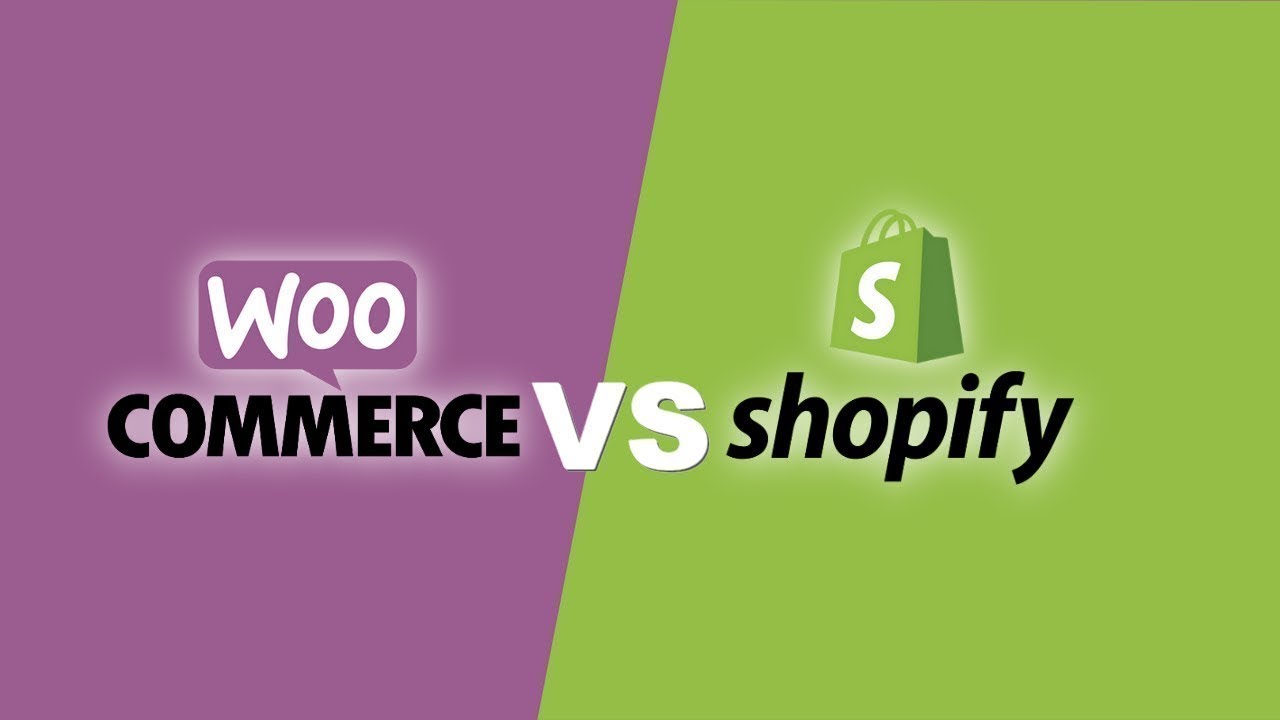Shopify vs. Woo Commerce: Which is Best for Online Marketing?

Shopify vs. Woo Commerce: Pros and Cons of Each Platform
Introduction
When it comes to starting an online store, choosing the right e-commerce platform is crucial. Shopify and Woo Commerce are two of the most popular platforms on the market, each with their own unique features and benefits. Shopify is known for its ease of use and powerful marketing tools, while Woo Commerce offers next-level customization for high-volume stores. As an e-commerce entrepreneur, online retailer, dropshipper, or small business owner, it's important to choose the platform that best fits your needs. In this blog post, we'll compare Shopify and Woo Commerce based on several criteria including ease of use, integration with other tools, scalability and customization, and pricing and fees. By the end of this article, you'll have a better understanding of which platform is best for your online marketing needs.
Ease of Use
When it comes to building an online store, ease of use is a crucial factor to consider. As an entrepreneur or small business owner, you want a platform that allows you to set up and manage your store with minimal hassle. In this section, we'll compare Shopify and Woo Commerce in terms of ease of use.
Shopify
Shopify is known for its intuitive and user-friendly interface, making it easy for anyone to create an online store without any coding skills. With its drag-and-drop website builder, you can easily customize your storefront and add products in just a few clicks. The platform also offers a wide range of templates that are designed to be visually appealing and mobile-responsive.
Another advantage of Shopify's ease of use is the simplicity of its checkout process. Customers can complete their purchases quickly and efficiently, which can help increase conversion rates. Additionally, Shopify has a robust app store that allows you to add features like social media integration, email marketing campaigns, and more.
Woo Commerce
Woo Commerce is built on WordPress, which means that it requires more technical knowledge than Shopify. If you're not familiar with WordPress or web development in general, there may be a steep learning curve when setting up your online store with Woo Commerce. However, if you have some coding skills or are willing to learn, Woo Commerce offers next-level customization options for high-volume stores.
One advantage of Woo Commerce's ease of use is the recently launched Woo Express feature. This feature streamlines the setup process by allowing users to import products from suppliers directly into their online stores. It also includes pre-built templates that make it easier to get started with designing your storefront.
Integration with Other Tools
When it comes to integrating with other tools, both Shopify and Woo Commerce offer a range of options. However, there are some differences in the ease and flexibility of these integrations.
Shopify
One of the key advantages of using Shopify is its extensive integration capabilities. The platform integrates seamlessly with over 100 payment gateways, including popular options like PayPal, Stripe, and Authorize.net. This means that you can easily accept payments from customers all over the world without having to worry about compatibility issues.
Shopify also offers easy integration with social media platforms like Facebook and Instagram. This allows you to sell products directly through your social media accounts, which can be a powerful way to reach new customers and increase sales.
In addition to these built-in integrations, Shopify offers an extensive library of third-party apps and plugins. These apps cover everything from email marketing to inventory management, and they can help you customize your store in a variety of ways.
The best part is that most of these apps are very easy to install and use. You don't need any technical knowledge or coding skills to take advantage of them – simply browse the app store, find an app that meets your needs, and click "install."
Woo Commerce
While Woo Commerce doesn't have quite as many built-in integrations as Shopify, it still offers a solid range of options. The platform integrates with several popular payment gateways, including PayPal and Stripe. However, it may require additional plugins for some less common payment gateways.
Woo Commerce also integrates with a number of other tools like accounting software and shipping providers. However, some of these integrations may require more technical knowledge than those offered by Shopify.
Another potential downside is that Woo Commerce's plugin library is not as extensive as Shopify's app store. While there are still plenty of options available for customization and optimization, you may need to do more research before finding the perfect plugin for your needs.
Scalability and Customization
When it comes to scaling your online business, both Shopify and Woo Commerce offer great options. However, there are some differences in how they approach scalability and customization and here they are.
Shopify
Shopify is a highly scalable platform that can accommodate businesses of all sizes. Whether you're just starting out or have an established e-commerce store, Shopify has the tools you need to grow your business.
One of the benefits of using Shopify is that it's incredibly easy to set up and use. You don't need any coding knowledge to get started with this platform, which makes it a great option for entrepreneurs who are just starting out.
However, one downside of using Shopify is that it's not as customizable as some other e-commerce platforms. While there are plenty of themes and templates available in the Shopify app store, if you want to make more advanced customizations, you'll need to know how to code.
That being said, if you're looking for a platform that's easy to use and can be scaled quickly, Shopify is definitely worth considering.
Woo Commerce
Woo Commerce is another great option when it comes to scalability and customization. This platform is highly customizable and allows you to create a truly unique online store that reflects your brand's personality.
One of the benefits of using Woo Commerce is that it's built on top of WordPress, which means that if you're already familiar with WordPress, you'll find it easy to use this platform as well.
However, one downside of using Woo Commerce is that it may require more resources than other platforms in order to scale effectively. If you're planning on building a high-volume store with lots of products and traffic, you may need more powerful hosting than what's offered by typical shared hosting providers.
Additionally, while Woo Commerce is highly customizable, this can also be a drawback for some users. If you don't have coding knowledge or experience working with WordPress themes and plugins, getting your store set up exactly how you want it may be more challenging than with other platforms.
Pricing and Fees
One of the most important factors when choosing an e-commerce platform is pricing and fees. Both Shopify and Woo Commerce offer different pricing models that cater to different business needs and we will discuss them here.s
Shopify
Shopify offers a range of pricing plans, starting from $29 per month for the Basic plan, up to $299 per month for the Advanced plan. Each plan comes with different features and benefits, such as gift cards, professional reports, and advanced report builder. In addition to monthly subscription fees, Shopify also charges transaction fees for third-party payment gateways. The fees range from 2.4% + 30¢ to 2.9% + 30¢ per transaction, depending on the chosen pricing plan. Some apps and features may also come with additional fees.
While these costs may seem steep at first glance, it's important to consider the value that Shopify provides in terms of its powerful marketing tools and multi-channel selling capabilities. For businesses looking to expand their reach across multiple platforms and channels, Shopify's pricing plans may be worth the investment.
Woo Commerce
Woo Commerce is an open-source platform that can be downloaded for free from WordPress.org. However, using Woo Commerce requires hosting and domain fees which can range from $5-$25 per month or more depending on your hosting provider. Unlike Shopify, Woo Commerce does not charge any transaction fees for sales made through its platform.
That being said, some plugins and extensions for Woo Commerce may come with additional fees. These costs can add up quickly if you need a lot of customization or advanced functionality on your store.
Overall, while Woo Commerce may seem like a more cost-effective option at first glance due to its lack of subscription or transaction fees, it's important to factor in other costs such as hosting and plugin expenses when comparing it to Shopify.
Conclusion
When it comes down to choosing between Shopify vs Woo Commerce for online marketing needs such as dropshipping, suppliers or small business owners there are many factors to consider including ease of use integration with other tools scalability customization pricing & fee structure etc. Both platforms have their own unique strengths and weaknesses when it comes down to these factors but ultimately it depends on what your specific business needs are. If you want an easy-to-use platform with powerful marketing tools multi-channel selling capabilities then choose Shopify. But if you're looking for a more customizable solution that allows you greater control over your store then go with Woo Commerce. Regardless of which platform you choose both offer excellent options for businesses looking to establish an online presence in today's digital marketplace!
See Also
Choosing the Best AI Writing Tool for Content Marketing and Copywriting: Copy.ai vs Jasper.ai
E-Commerce Made Easy: Understanding Shopify's Purpose and Third Party Integrations
Blogging and Content Marketing: Understanding the Differences and How to Combine Them Effectively
Product Landing Pages: Defining, Tracing the History, and Identifying Key Features
Landing Pages: Defining, Highlighting Features, and Predicting Future Trends

